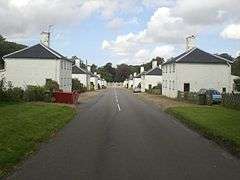Houghton, Norfolk
| Houghton | |
|---|---|
 The Street in New Houghton, showing the houses that were built in 1729 to replace those demolished to make way for Houghton Hall and park. | |
 Houghton Houghton shown within Norfolk | |
| Area | 7.64 km2 (2.95 sq mi) |
| OS grid reference | TF789288 |
| • London | 98 miles |
| Civil parish |
|
| District | |
| Shire county | |
| Region | |
| Country | England |
| Sovereign state | United Kingdom |
| Post town | KING'S LYNN |
| Postcode district | PE31 |
| Police | Norfolk |
| Fire | Norfolk |
| Ambulance | East of England |
| EU Parliament | East of England |
Houghton is a small village and a civil parish in the English county of Norfolk. It covers an area of 7.64 km2 (2.95 sq mi) and had a population of 69 in 36 households at the 2001 census.[1] At the 2011 Census the population of the village still fell less than 100 and was included in the civil parish of West Rudham. For the purposes of local government, it falls within the district of King's Lynn and West Norfolk. It is the location of Houghton Hall, a large country house built by Robert Walpole, the first Prime Minister of the United Kingdom.
History
The village is listed as Houtuna in the Domesday Book of 1086.[2] It takes its name from the Old English language; hoh (hill-spur) plus tun (enclosure, settlement or farm). The old village of Houghton was demolished in 1722 to make way for the construction of Houghton Hall and the associated parkland. In 1729, the village was rebuilt on the edge of the estate and called "New Houghton";[3] the 33 surviving houses are all now Grade II listed buildings. It is one of the locations claimed to be the inspiration for Oliver Goldsmith's poem The Deserted Village[4] In 1872, the parish had 53 houses and 227 inhabitants. Other names for the village were Houghton-in-the-Brake and Houghton-Next-Harpley.[5] The parish church is inside the park and dates from the 13th century, although it was heavily restored in the 18th century when the tower was added.[6] Robert Walpole, 1st Earl of Orford and Horace Walpole are buried in the church, which is a Grade I listed building.[7]
Notes
- ↑ Census population and household counts for unparished urban areas and all parishes. Office for National Statistics & Norfolk County Council (2001). Retrieved 20 June 2009.
- ↑ The Domesday Book Online - Norfolk H-L - Houghton (near West Rudham)
- ↑ Samuel Lewis, A Popular Guide to Norfolk Place Names, The Lark's Press, 1991 ISBN 0-948400-15-3 (p.25)
- ↑ British Listed Buildings - 1, 2 and 3, the Street, Houghton
- ↑ A vision of Britain Through Time - Houghton Norfolk
- ↑ BBC Domesday Reloaded - St Martin's Church, Houghton
- ↑ British Listed Buildings - Church of St Martin, Houghton
External links
![]()